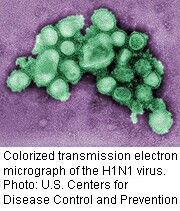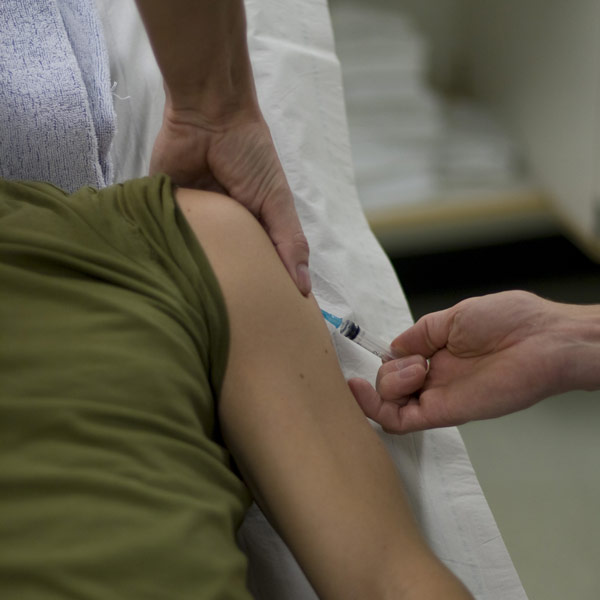
WEDNESDAY, May 5 (HealthDay News) — A year after the H1N1 flu first appeared, the World Health Organization has issued perhaps the most comprehensive report on the pandemic’s activity to date.
“Here’s the definitive reference that shows in black-and-white what many people have said in meetings and talked about,” said Dr. John Treanor, a professor of medicine and of microbiology and immunology at the University of Rochester Medical Center in New York.
The H1N1 flu disproportionately affected children and young adults, not the older adults normally taken by the traditional flu, states the report, which appears in the May 6 issue of the New England Journal of Medicine.
The review offers few new insights, said Dr. Len Horovitz, a pulmonary specialist with Lenox Hill Hospital in New York City, except “that pregnant women were more at risk in the second and third trimesters and the finding that obesity and morbid obesity [were also risk factors]. Obesity is something that has not been associated with influenza deaths before.”
The novel virus first appeared in Mexico in the spring of 2009. It has since spread around the globe resulting in “the first influenza pandemic since 1968 with circulation outside the usual influenza season in the Northern Hemisphere,” the report’s authors said.
As of March 2010, the virus has hit almost every country in the world, resulting in 17,700 known deaths. By February of this year, some 59 million people in the United States were hit with the bug, 265,000 of who were hospitalized and 12,000 of whom died, the article stated.
Fortunately, most of the illness tied to infection with H1N1 has remained relatively mild, comparatively speaking.
The overall infection rate is estimated at 11 percent and mortality of those infected at 0.5 percent.
“It didn’t have the kind of global impact on mortality we might have seen with a more virulent epidemic but it did have a very substantial impact on health-care resources,” Treanor said. “[Although] the mortality was lower than you would expect in a pandemic, that mortality did occur very much in younger people so if you look at it in terms of years of life lost, it becomes very significant.”
In direct opposition to the seasonal flu, most of the deaths have occurred in people under the age of 65 and notably in children and young adults. Children under the age of 5, especially those younger than than 12 months, have had the highest hospitalization rates.
Among the report’s other findings:
- H1N1 spread very much like the “regular” flu and has been common in crowded places such as schools, day-care settings, camps and hospitals.
- Like the seasonal flu, symptoms can include coughing, fever and a sore throat but, unlike the seasonal flu, many people had gastrointestinal problems such as nausea, vomiting and diarrhea.
- Because symptoms can be similar, H1N1 may have been mistaken for other infections which are treatable, such as malaria or Legionnaire’s Disease.
- The virus does respond to Tamiflu (oseltamivir) and Relenza (zanamivir), but is mostly resistant to amantadine and rimantadine.
As for the near future, experts don’t expect to see a major resurgence.
“I think periodically we’re going to get ups and down, depending on the area of the country and what the conditions were, if it was crowded, if there were a lot of immunosuppressed individuals. But the numbers, overall, will continue to be low,” said Dr. Mary desVignes-Kendrick, a research scientist in epidemiology and biostatistics at Texas A&M Health Science Center School of Rural Public Health in Houston.
Public health officials have recently seen an uptick in cases in the southeastern United States.
A vaccine for this season’s version of H1N1 is available and one will be available for 2010 but, Horovitz said, few people are going to get it. “That’s the burnout that can occur when people have heard too much about something,” he explained.
Now experts are looking toward the Southern Hemisphere, especially Australia, for clues into how this year’s flu season in the north will evolve.
“This was a good wake-up call, if we needed one, that you would have to prepare for different subgroups [than the seasonal flu],” said desVignes-Kendrick. “It affects children, young adults, those with no particular health problems, so you would not consider them to be particularly vulnerable. It’s a wake-up call that we have to be vigilant and have to keep searching for clues and ways to detect it early.”
More information
Find out the latest on H1N1 at theU.S. Centers for Disease Control and Prevention.

